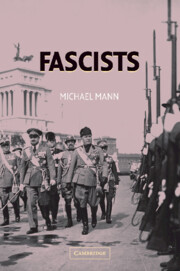Book contents
- Frontmatter
- Contents
- Preface
- 1 A Sociology of Fascist Movements
- 2 Explaining the Rise of Interwar Authoritarianism and Fascism
- 3 Italy: Pristine Fascists
- 4 Nazis
- 5 German Sympathizers
- 6 Austro-Fascists, Austrian Nazis
- 7 The Hungarian Family of Authoritarians
- 8 The Romanian Family of Authoritarians
- 9 The Spanish Family of Authoritarians
- 10 Conclusion: Fascists, Dead and Alive
- Appendix
- Notes
- Bibliography
- Index
6 - Austro-Fascists, Austrian Nazis
Published online by Cambridge University Press: 05 June 2012
- Frontmatter
- Contents
- Preface
- 1 A Sociology of Fascist Movements
- 2 Explaining the Rise of Interwar Authoritarianism and Fascism
- 3 Italy: Pristine Fascists
- 4 Nazis
- 5 German Sympathizers
- 6 Austro-Fascists, Austrian Nazis
- 7 The Hungarian Family of Authoritarians
- 8 The Romanian Family of Authoritarians
- 9 The Spanish Family of Authoritarians
- 10 Conclusion: Fascists, Dead and Alive
- Appendix
- Notes
- Bibliography
- Index
Summary
During World War II the Allies proclaimed Austria “the first victim of Nazi aggression.” To define the 1938 Anschluss as a German invasion was to depict Austrians as innocent victims and Austrian fascists as a clique of collaborators, not a national mass movement. This is a distinctive way of not taking them seriously. The youthful wartime activities of the U.N. Secretary-General Kurt Waldheim that were revealed in 1988 shocked the world because they seemed to put him into this terrible extremist clique. Yet the truth is more shocking. Waldheim was no deviant, just a young, ambitious Austrian officer “doing his duty” (he said), assigned in the Balkans to assist in what the regimental reports termed “cleansings” to be carried out “without pity or mercy,” since “only a cold heart can command what needs to be commanded.” The majority of the Austrian electorate may have also thought this normal Austrian behavior, since despite the revelations they then voted him in as President of Austria (Ashman and Wagman 1988: chap. 4; Sully 1989).
Indeed, Austria might seem the most fascist country in the interwar world, since it had two fascist movements, each with mass support, each able to seize power and to govern the country. Yet some of their success was due to Austria's position as a lesser Germanic power. The successes of Hitler were especially admired and emulated in Austria.
- Type
- Chapter
- Information
- Fascists , pp. 207 - 236Publisher: Cambridge University PressPrint publication year: 2004



